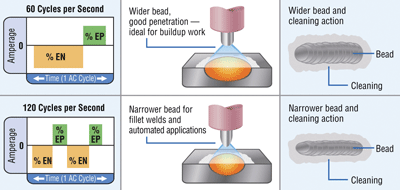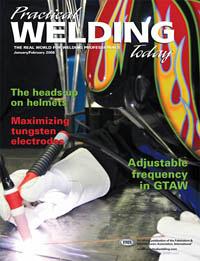Contributing Writer
- FMA
- The Fabricator
- FABTECH
- Canadian Metalworking
Categories
- Additive Manufacturing
- Aluminum Welding
- Arc Welding
- Assembly and Joining
- Automation and Robotics
- Bending and Forming
- Consumables
- Cutting and Weld Prep
- Electric Vehicles
- En Español
- Finishing
- Hydroforming
- Laser Cutting
- Laser Welding
- Machining
- Manufacturing Software
- Materials Handling
- Metals/Materials
- Oxyfuel Cutting
- Plasma Cutting
- Power Tools
- Punching and Other Holemaking
- Roll Forming
- Safety
- Sawing
- Shearing
- Shop Management
- Testing and Measuring
- Tube and Pipe Fabrication
- Tube and Pipe Production
- Waterjet Cutting
Industry Directory
Webcasts
Podcasts
FAB 40
Advertise
Subscribe
Account Login
Search
What's your frequency
The role of adjustable output frequency in GTAW
- By John Luck
- January 15, 2008
- Article
- Arc Welding
Before the advent of inverter-based gas tungsten arc welding (GTAW) machines, frequency control was rarely thought of as a way to improve aluminum welding. The current that came from the wall—60 hertz—was the same current that went into the weld. Since then countless manufacturers have sworn off this mentality after seeing firsthand the benefits of adjustable output frequency.
In alternating current (AC) GTAW, frequency refers to the number of times that the direction of the electrical current completes a full cycle every second, expressed in hertz. Frequency is represented by a sine wave, which depicts the current flow rising and falling as it reverses direction.
Direct current (DC) cannot be used with nonferrous metals because of the oxide layer that forms on the surface of the base material. In direct current electrode negative (DCEN) GTAW, the current flows from the tungsten electrode to the work surface, and the positively charged argon gas ions flow from the work surface to the tungsten. DCEN works well for steel and other common ferrous metals, but the oxide layer that forms on nonferrous metals such as aluminum and magnesium melts at a higher temperature than the base metal. Trying to weld with this process causes the base metal underneath the oxide layer to liquefy while the surface remains hard and impenetrable.
Direct current electrode posititive (DCEP) solves the oxide problem because the current flows from the workpiece to the tungsten, lifting the oxide off the material in the arc zone. DCEP alone provides the oxide cleaning action and very little penetration. Because the heat is concentrated on the tungsten instead of the workpiece, DCEP also causes the tungsten to ball up at the end.
AC, then, combines DCEN and DCEP to provide good heat penetration with cleaning action. Historically, though, AC has posed an obstacle to GTAW because the arc frequently extinguishes itself as the current reaches a zero point before reversing directions. Without any current passing between the tungsten and the base metal, the arc simply goes out.
Improvements in transformer-based GTAW machines created the square wave, which increased the amount of time the arc spends at full-current flow in both DCEN and DCEP. Square-wave technology eliminated the tendency for the arc to extinguish when the current came to a halt as it reversed directions by making the transition very quickly. This greatly improved the stability of the arc and made square-wave technology the preferred method for GTAW of aluminum and other materials that form an oxide layer, such as magnesium.
The second major revolution in frequency technology came with the invention of the inverter, which created the ability to increase or decrease output frequency beyond the standard 60 Hz, which is the standard frequency delivered to every outlet in the U.S. (other countries, such as Germany, England, and France, deliver AC power at 50 Hz). The inverter also allowed for the development of the advanced square wave, which decreases the time it takes for the current to reverse directions, increasing arc stability even more and eliminating the need for continuous high frequency.
Inverter Basics
A traditional power source uses a large, heavy transformer to turn high-voltage, low-amperage primary power into the low-voltage, high-amperage power needed for welding. An inverter power source takes input power, filters it to DC, and, increases its frequency up to 100,000 Hz with fast, solid-state switches. Input power then is transformed into usable, and then transforms it into useable welding power with an advanced level of arc control. The higher frequency allows inverter-based machines to have much smaller transformers, which greatly reduces the overall size and weight of the machines.
The range of available Most inverter-based power sources provide AC output frequencies between 20 Hz and 150 Hz. Miller inverter TIG machines provide AC output frequencies between 20-400 Houtput frequencies varies widely by manufacturer. Some companies offer machines with frequencies from 20 to 100 Hz, while others make machines outputting 20- to 400-Hz. Power sources could be designed to provide frequencies outside of the 20 to 400 Hz range, but very few welding situations would benefit from such frequencies. In general, 120 to 200 Hz is a suitable frequency for most aluminum welding.
Controlling the Arc Cone
Increasing frequency above 60 Hz causes the current to change direction more often, which means that it spends less time per cycle in both DCEN and DCEP mode. By spending less time at each polarity, the arc cone has less time to expand.

AC Frequency control controls the width of the arc cone. Increasing the AC frequency provides a more focused arc with increased directional control. Decreasing the AC frequency softens the arc and broadens the weld puddle for a wilder weld band.
An arc cone at 400 Hz is much tighter and more focused at the exact spot the electrode is pointing than an arc cone operating at 60 Hz (see Figure 1). The result is significantly improved arc stability, ideal for fillet welds and other fit-ups requiring precise penetration.
Combined with adjustable balance control to increase the electrode negative polarity—resulting in deeper penetration and tungsten that doesn't ball up—high AC frequency can weld very tight joints with good penetration and without the risk of laying down too much filler metal. Workpieces with wide gaps to fill or that require buildup will benefit from the softer, wider arc cone that results from lower frequencies (Figure 1).
Unlike other types of waveform control, such as balance and amplitude, frequency control provides good penetration at both low and high frequencies. The primary difference between the two is the width of the arc cone and resulting weld bead.
Narrowing the Bead with Frequency Control: An Example
A1A Dock Products, Hollywood, Fla., a manufacturer of aluminum ladders, decided to take advantage of advanced GTAW controls and invested in equipment with adjustable frequency. The higher frequency the company was able to use, 150 Hz, and balance control, set at 75 percent electrode negative, allowed A1A to increase its production by eight ladders per day.
Derek Grundler, production manager at A1A, said the equipment allowed for fast welding and created a narrower weld bead than the previous GTAW machine they were using, because the welders could direct the arc instead of direct the arc spreading it out. The technology also let welders sharpen the tungsten like a pencil point and maintain a point so the arc came off of the tip instead of dancing around a balled tungsten and creating a wide bead.
Maintaining a narrow weld bead was important for A1A. A welder who laid down a 5/16-in. bead where a 3/16-in. bead was called for took three times longer per foot and laid down 177 percent more weld metal than necessary. Figuring out the ideal settings for their applications took the welders a little more time than simply adjusting voltage and amperage, but once they got the parameters right, the results were well worth the effort.
About the Author
John Luck
1635 W. Spencer St. P.O. Box 1079
Appleton, WI 54912
800-426-4553
About the Publication
subscribe now

The Welder, formerly known as Practical Welding Today, is a showcase of the real people who make the products we use and work with every day. This magazine has served the welding community in North America well for more than 20 years.
start your free subscription- Stay connected from anywhere

Easily access valuable industry resources now with full access to the digital edition of The Fabricator.

Easily access valuable industry resources now with full access to the digital edition of The Welder.

Easily access valuable industry resources now with full access to the digital edition of The Tube and Pipe Journal.
- Podcasting
- Podcast:
- The Fabricator Podcast
- Published:
- 04/16/2024
- Running Time:
- 63:29
In this episode of The Fabricator Podcast, Caleb Chamberlain, co-founder and CEO of OSH Cut, discusses his company’s...
- Industry Events
16th Annual Safety Conference
- April 30 - May 1, 2024
- Elgin,
Pipe and Tube Conference
- May 21 - 22, 2024
- Omaha, NE
World-Class Roll Forming Workshop
- June 5 - 6, 2024
- Louisville, KY
Advanced Laser Application Workshop
- June 25 - 27, 2024
- Novi, MI
































